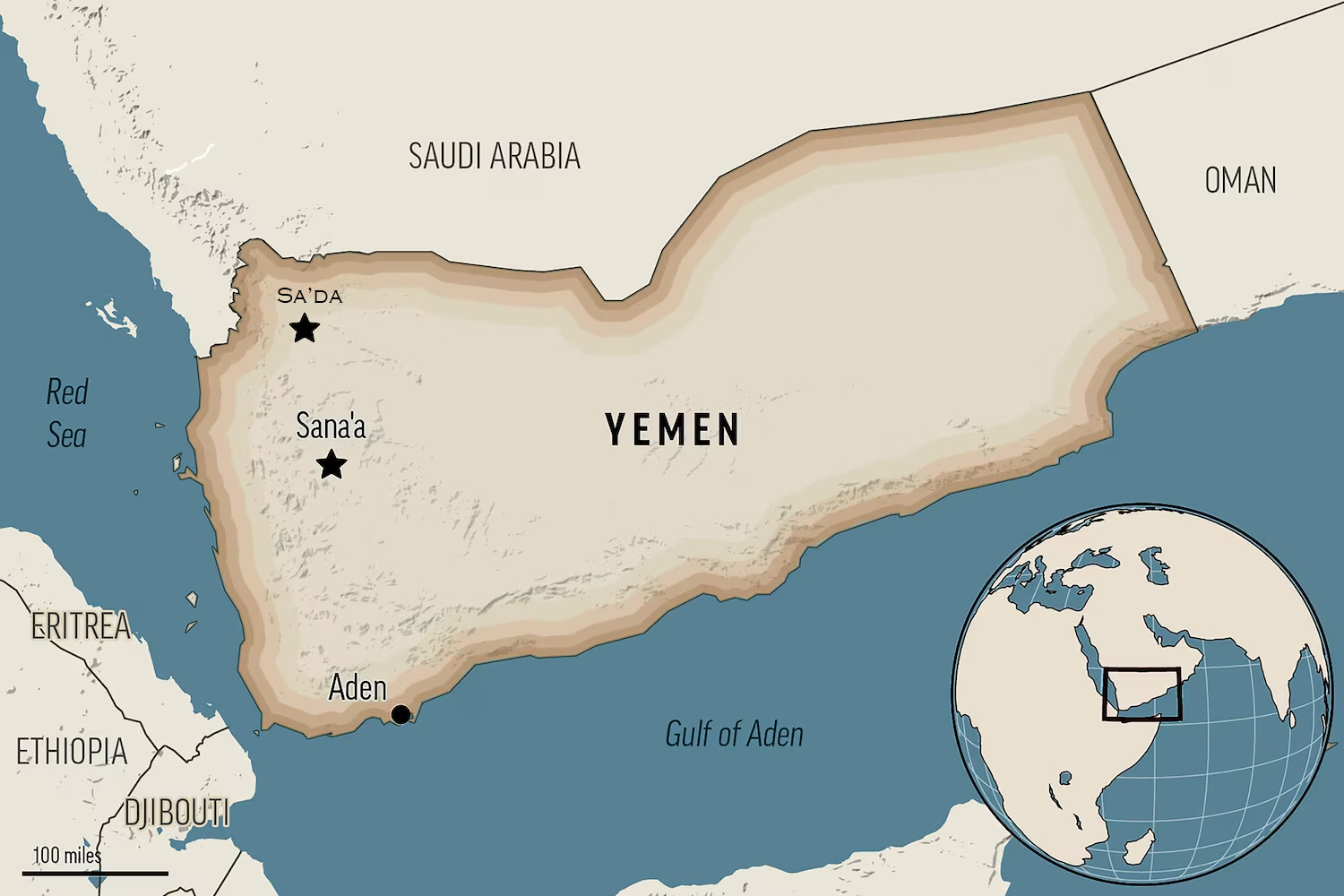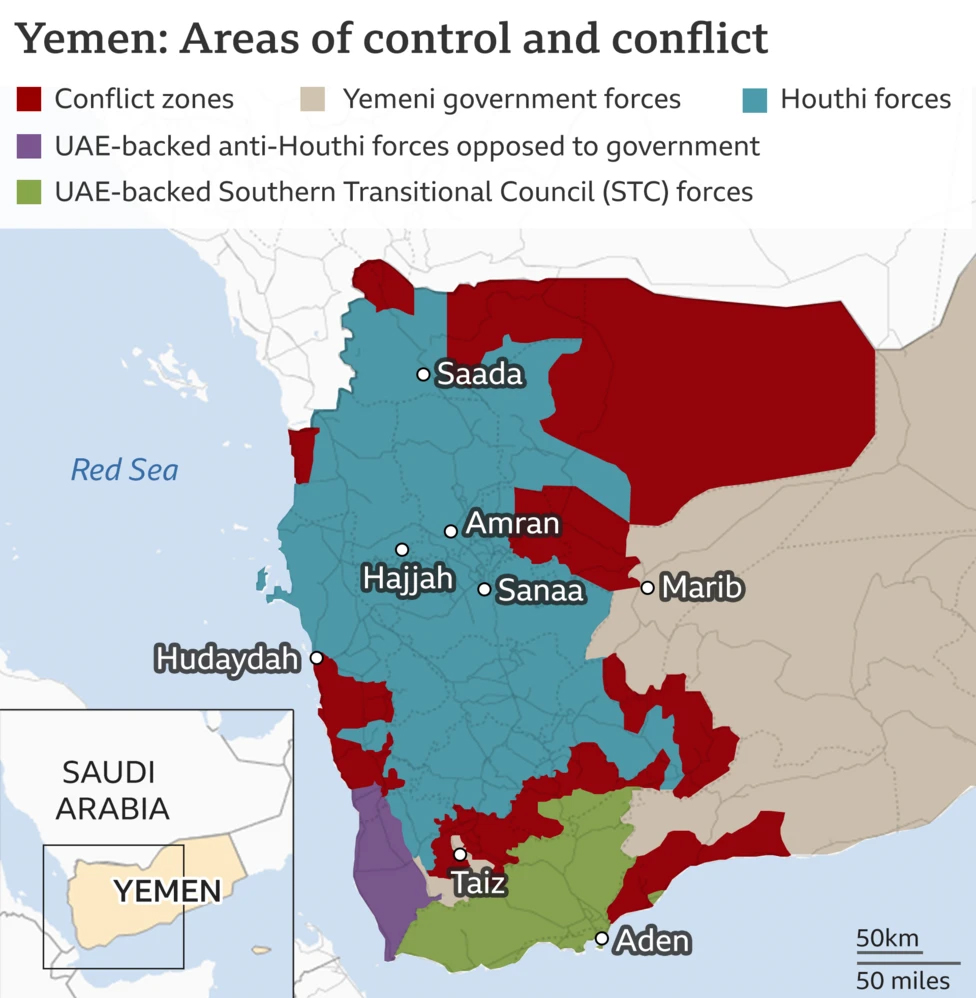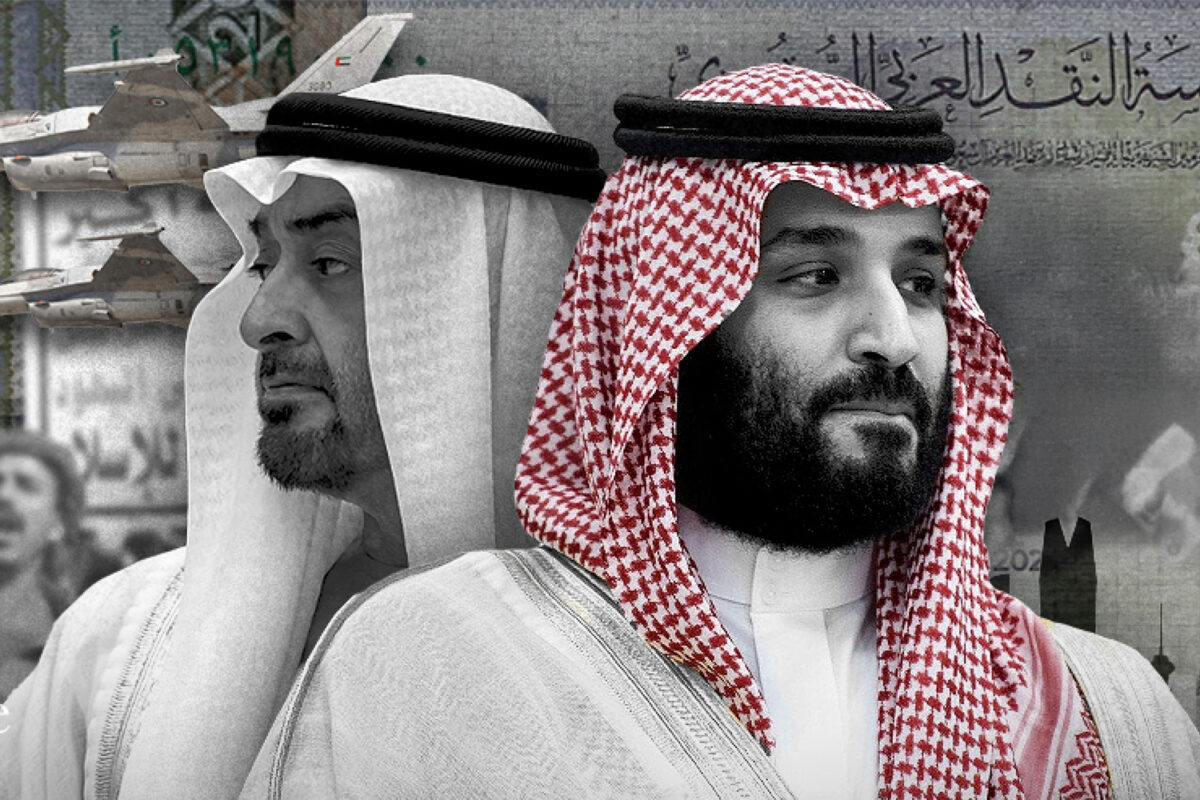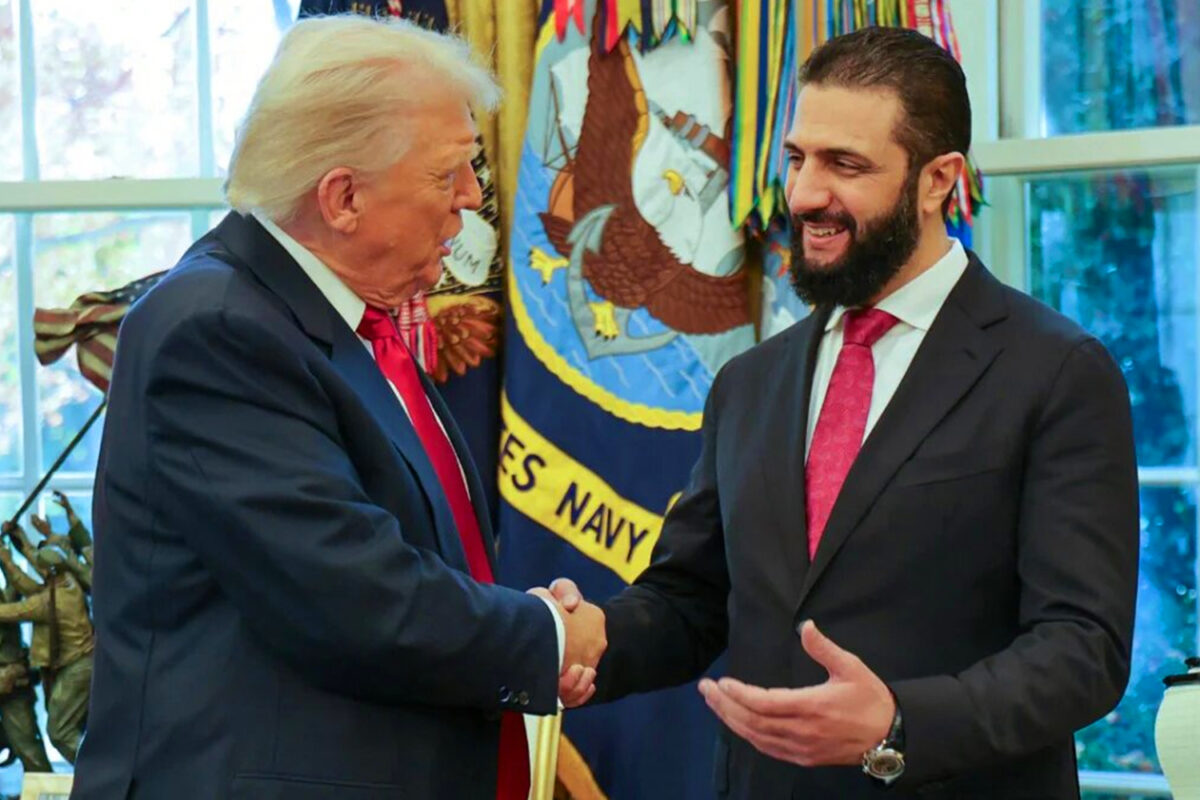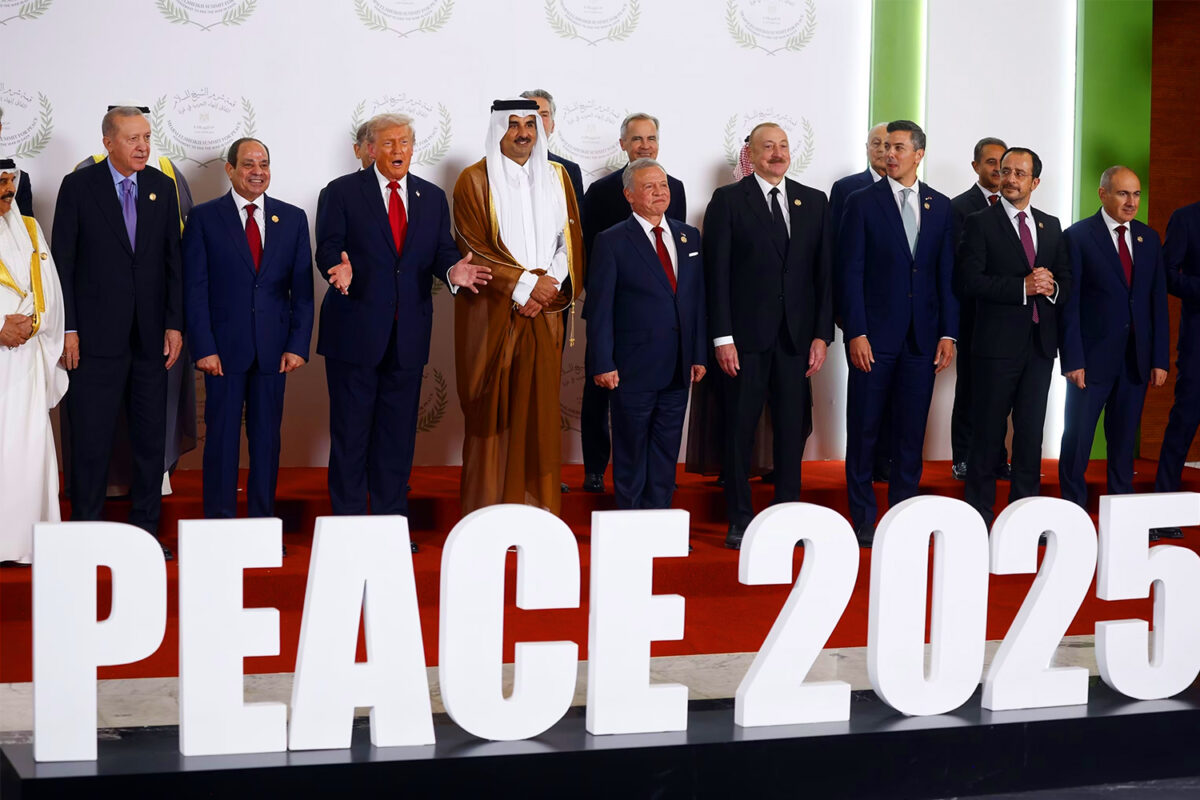The Houthis made headlines in 2023 when they boarded the Galaxy Leader, an Israeli linked sea vessel, leading to the expansion of the war in Gaza to the Red Sea. The Houthis’ targeting of Israel with ballistic missiles has seen them shoot to fame across the world and put the Axis of Resistance – Iran’s informal political and military coalition in the Middle East – on the map. By the 12th of January 2024 Operation Prosperity Guardian, a coalition of western allies, launched airstrikes against Yemen and subsequently Israel also conducted its own airstrikes against Yemeni targets. The Houthis are Iran’s lesser-known entity and whilst they have gained global media coverage they face immense challenges domestically and it’s this that is driving its risky escalation strategy abroad.
The Houthis are a tribe from Sa’ada in North Yemen who over the last few decades came to dominate its regional mountainous terrain and eventually challenge the national government that was based in the capital Sanaa. The north and south of Yemen have, in the past, been under the control of various powers both local, regional and international. Yemen’s coasts along the Red Sea and the Bab al-Mandab Strait attracted the European imperialists who eventually established trading posts. When the US emerged as a global power after WW2 it came to see Yemen as part of its regional strategy to stop the spread of communism in the region. In 1990 both North and South Yemen were united as one nation and subsequent elections for the combined Yemen saw Ali Abdullah Salah emerge as the leader. He subsequently established a patronage system to maintain his grip on power and this led to state resources and the nation’s resources being used to maintain his power base. The regime in Saana led by Ali Abdullah Saleh treated all the northern Yemen tribes as enemies and this eventually led to the rise of the Houthis.
From Imamate to Republicanism
The Houthis are Zaydies, who take their name from Zayd bin Ali, the great grandson of Ali. Zayd bin Ali was martyred in a revolt against the Umayyad caliphate in 740. Ever since, Zaydis believed he was a model of a pure caliph who should have ruled instead of the Umayyads. The followers of Zayd established themselves in north Yemen’s rugged mountains in the ninth century. For the next thousand years, the Zaydis fought for control of Yemen with various degrees of success. A succession of Zaydi Imams ruled the community and Zaydis were the majority of the population in the mountains of North Yemen. They fought against both the Ottomans and the Wahhabis in the 18th and 19th centuries. With the collapse of the Ottomans in 1918, a Zaydi monarchy took power in North Yemen called the Mutawakkilite Kingdom. The imam fought and lost a border war with Saudi Arabia in the 1930s, but they were recognised as the legitimate government of North Yemen.
In 1962, an Egyptian-backed revolutionary military cabal overthrew the Mutawakkilite king and established an Arab nationalist government with its capital in Sanaa. With Soviet assistance, Egypt sent tens of thousands of troops to back the republican coup. The Zaydi Royalists fled to the mountains along the Saudi border to fight a civil war for control of the country. The Zaydi republican general Ali Abdullah Saleh came to power after a succession of coups in 1978. The Houthis would emerge as resistance to Saleh and his corruption in the 1990s.
The Houthis
The origin of the Houthis goes back to Badr al-Din al-Huthi, born in the late 1950’s. He was a religious scholar and considered a “sadah” – descendant of the Prophet Mohammad. Badr al-Dins four marriages and 14 sons and their descendants dominate the Houthi tribe today. Badr al-Din and his sons were members of the minority Jarudi sect of Zaydism, which is close to Shi’ah Islam. When the revolution took place in Iran in 1979 Badr al-Din was a politically receptive, young man in his twenties. He and his family enthusiastically embraced Ayatollah Khomeini and his revolutionary ideas. The Iranian regime’s version of Twelver Shi’ism was for al-Din the true Zaydism because it mobilised the masses to confront foreign powers and unjust rulers. Badr al-Din and his father visited Iran for intermittent stays between 1979 and until his death in 2010.
The Houthis built their credibility in northern Yemen by organising religious students to go to Qom seminaries
In the 1990s Badr al-Din began sending students to Qom for religious studies. This flow of students eventually produced a cadre of around 800 Qom-trained students, some of whom were also groomed by the Islamic Revolutionary Guard Corps (IRGC) with paramilitary training. When Badr al-Din returned from Khartoum after doing a year of religious studies in 1989 Sudan at the time was the main station on the red Sea for the IRGC. Al-Din introduced the now infamous slogan that supercharged the Houthi movement, “the scream” (al-shi‘ar): “Death to America, Death to Israel, Curse upon the Jews, Victory to Islam.”
The Houthis built their credibility in northern Yemen by organising religious students to go to Qom seminaries. They organised summer camps that saw thousands attend religious indoctrination. Alongside this they organised many social and educational programs under their stewardship.
Fighting the regime
With Houthis growing power and influence, mixed with religious fever the government in Sana’a launched the first of its many wars against Northern Yemen. These battles began in 1999 and led to the Houthis winning over many tribes in Sa’da. As the regime carried out atrocities, the Houthis won more support and developed their fighting capabilities. From 1999 to the Arab Spring in 2011 the Houthis were at constant war with the Yemeni government and its supporters.
In the first few years, the Houthis fought an increasingly effective guerrilla war in their mountainous home province, they would in time metamorphosis into the most powerful military entity in the country. The Houthis faced-off against government forces, carried out ambushes and targeted military supply lines. In the decade of war, they went from ambushes and guerrilla war to assassinations to using heavy weapons and systems. By 2010 the Houthi movement was confident enough to force the surrender of an entire Yemeni brigade and mount a major assault at battalion strength (240-360 strong) with armoured vehicles on Sa’ada, seizing parts of the city from the government. They even initiated offensive raids into Saudi Arabia.
When the Arab Spring kicked-off in 2011 the regime in Sanaa had been at war for over a decade and was struggling financially. Its military had been expelled from Northern Yemen. The Arab Spring gave further impetus to the Houthis and the North Yemeni tribes as the Yemen government was oppressive and they came to see their uprising as part of the wider Arab Spring. The regime by this point was regularly using heavy artillery in its battles against civilians and fighters. The regime fought 6 wars from 2000-2011 against Houthi forces but failed to defeat the Houthis who had now grown into a capable force.
As the regime carried out atrocities, the Houthis won more support and developed their fighting capabilities
From 2011, safe in their mountainous base the Houthis organised and moved towards the capital in Sanaa. By 2014 the state had collapsed and what remained was forced to shift to the port city of Aden. This collapse allowed the Houthis and their forces to acquire and seize heavy military equipment and weapons. It was here Iran and Hezbollah increased their support to the Houthis providing help, training and equipment. In 2011 the Houthis gained full control of the Midi port and its believed arms and equipment flowed uninterrupted.
From Guerrillas to Statesmen
By 2015, after nearly two decades of warfare the Houthis adopted the name – Ansar Allah for their movement. It was also the year they overran the Yemeni government’s fallback capital of Aden. This now meant Ansar Allah had a 180-mile supply line from Sana’a. This was the longest-ranged offensive action ever undertaken by the group, and it coincided with a number of other offensives toward Mar’ib, Hodeida, Ta’izz, Ibb, Bayda, and Shabwah, which largely failed to dislodge the defenders there.
The Houthis found, once in government, they may have controlled up to 70% of the nation’s population but they only had a small fraction of the pre-war income to do this with
At this point the Houthis had become a state-level actor with powerful international allies. They needed to transition from fighting and warfare to ruling and international relations. Here they have faced immense challenges.
The Houthi frontline expanded from around 400 miles in early 2014 to nearly 1,000 miles by the summer of 2015. The area occupied by Houthi forces increased from around 11,000 square miles in 2014 to 46,000 square miles in 2015. The population controlled by the Houthis rose from little more than 2 million at the start of 2014 to 24 million by 2023. The Houthis in government faced the same challenge as the regime they had long fought. North Yemen was heavily populated, many lived in poverty, the terrain was monotonous so lacked infrastructure and the people were fiercely tribal. North Yemen is difficult for anyone to rule, including the Houthis.
The Houthis found, once in government, they may have controlled up to 70% of the nation’s population but they only had a small fraction of the pre-war income to do this with. The Houthis quickly found it was unable to pay the salaries of civil servants, many teachers have not been paid for months. This has resulted in escalating pickets and public sector strikes in urban areas.
Regional developments caused even bigger problems. Just a few months after the Houthis captured the government and the country in 2015, Saudi Arabia unleashed a full-scale military campaign against the Houthis. The Saudis assembled a coalition of nine states, and they made clear that they considered the Houthis, who were allied with Iran, a mortal threat on their southern border. The Saudi intervention turned much of Yemen into a wasteland and has killed over 377,000 civilians, mostly in errant airstrikes. Saudi airstrikes heavily bombed Yemen’s civilian infrastructure, such as hospitals, schools and markets. Some 14 million people still face starvation, in what the United Nations has said is the worst famine seen in the world in 100 years. Disease is rampant, including the world’s worst modern outbreak of cholera.
Just a few months after the Houthis captured the government and the country in 2015, Saudi Arabia unleashed a full-scale military campaign against the Houthis. The Saudi intervention turned much of Yemen into a wasteland and has killed over 377,000 civilians, mostly in errant airstrikes
During Saudis bombing campaign Southern separatists, led by the Southern Transitional Council (STC), emerged and began to assert themselves and declared self-rule in 2020. Despite the involvement of the US and global and regional powers no-one, even the Houthis have been able to assert full authority over all of Yemen. When the October 7th assault took place, in Yemen there was an assortment of factions, controlling some territories and fighting over others. The Houthis controlled the North of Yemen including the former capital of Sana’a. In the South of Yemen there is a coalition of former regime factions alongside other tribal factions who all receive support on and off from the regional and global powers. The Houthis faced no real prospect of military defeat in the civil war, which placed them in an advantageous position in the peace process. Saudi Arabia and the UAE long supported the former regime and its coalition but were not prepared to restart its military support to them and the US sought a rapid conclusion to the war in order to roll into a planned normalisation deal involving Israel and Saudi Arabia.
Popular mobilisation
The Houthi strategy, amongst all the challenges they faced and with a domestic population to also take care of, pushed them to popular mobilisation. This is a strategy authoritarian regimes have used in the past and something Iran also used after the revolution in 1979. Iran invested significant amounts into building a human resource system that would act as a vanguard of the revolutionary regime and be the catalyst in spreading the revolution. Iran established both internal and external organisations that kept the country on a war-like footing and led to the indoctrination of a generation of youth.
The Houthi leadership increased popular mobilisation and indoctrination as a means of reducing resistance to Houthi misrule. The Houthis have invested significant effort in developing a comprehensive military human resources system with the Houthis claiming a mobilisation capacity of 708,000 personnel before the Gaza conflict. All of this is run as a formal government institution and has seen the Houthi movement become an effective recruiting, motivating, and training force. This war economy has driven the brutal cannibalisation of whatever assets remain, which means they cannot be used for the benefit of the broader population who are facing the grim prospect of poverty and malnutrition.
The Houthi leadership increased popular mobilisation and indoctrination as a means of reducing resistance to Houthi misrule
This was the context the Houthis were in when October 7th took place. In many ways it came at the right time as domestic unrest was growing against Houthi rule. The civil war was seeing both Saudi Arabia and UAE losing interest with the US also looking to exit. The Houthis committed themselves to entering into an open war with Israel that other members of the Axis didn’t. The Houthis began launching attacks against Israel immediately whilst Iran waited 6 months before they responded, whilst Hezbollah until recently maintained limited operations against Israel. The Houthis commenced their first attack with a cruise missile and drone attack on Israeli territory from October 19th. The Houthis launched many attacks at ranges of up to 1,800 miles at relatively short notice, obliging Western militaries to use significantly more expensive interceptor systems.
The Houthis then threatened to begin targeting Israeli-linked shipping. In November 2023 after a number of failed speedboat chases of commercial vessels on November 17th the Houthis succeeded in intercepting and boarding a Galaxy Leader using a helicopter to land commandos, who then stopped the ship to allow a Houthi boat flotilla to catch up, which was then taken to a Yemen port. Whilst this was a major propaganda victory the Houthis found it hard to replicate. Despite other efforts to seize vessels in the Red Sea no other ship was successfully boarded or seized.
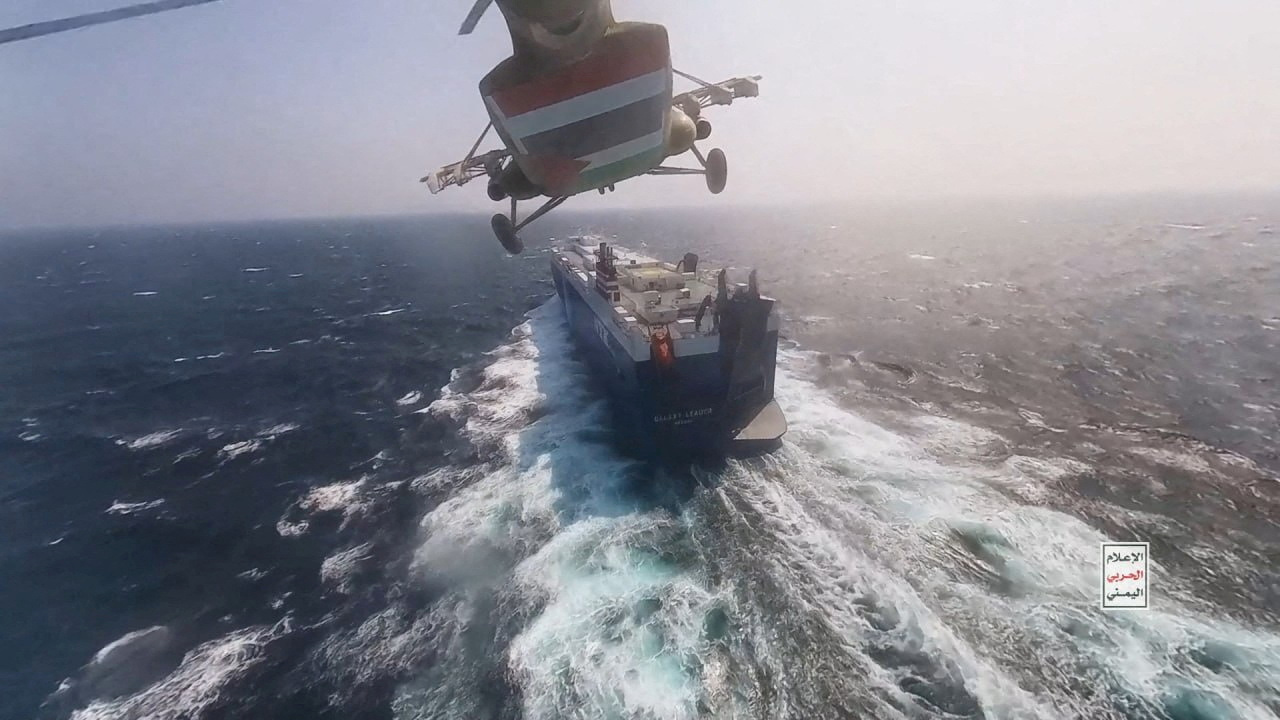
Whilst the Houthis have gained considerable global attention, this is disproportionate to their accomplishments. Despite all their efforts, the Houthis have failed to land a single effective blow on Israel with only one ballistic missile penetrating Israel’s defences and they only sank one ship. When facing the world’s most advanced militaries, the capabilities built in Yemen by the axis of resistance were comprehensively, though expensively, countered. Houthi air defence took down two MQ-9 drones but otherwise proved ineffective against higher-flying manned aircraft. Drone boats and helicopters lost most of their value once the US began to actively defend ships.
The Houthis have a deep alliance with Iran and have tried to copy their domestic policies and replicate them in Yemen. The Houthis gained considerable global coverage with bombastic statements and missile strikes at Israel and targeting of Israeli sea vessels, but the reality is they have had no impact on the on-going war and in fact this deflects from the dire situation the Houthis face domestically. The Houthi actions allow Iran to not use its conventional power to respond to Israeli atrocities as the Houthis are seen as a member of the Axis of Resistance. Even though the Houthis are focused on external objectives, their main challenges are in fact domestic.


